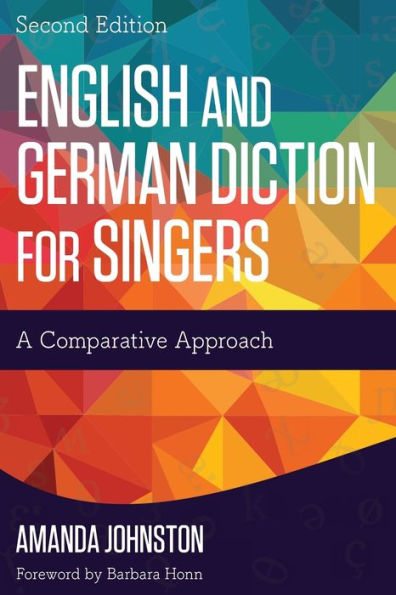Table of Contents
Musical Examples xiii
Foreword xv
Preface xix
Part I Introduction 1
Chapter 1 Elementary Concepts 3
1.1 Phonetics and the International Phonetic Alphabet 3
1.2 Vowel classification 4
1.3 Consonant classification 5
1.4 Organs of speech 7
1.5 Points of articulation 8
Chapter 2 Proficiency in English IPA 9
2.1 Vowels 9
2.2 Diphthongs 13
2.3 Triphthongs 16
2.4 Consonants 16
Chapter 3 Proficiency in German IPA 25
3.1 Vowels 25
3.2 Diphthongs 29
3.3 Consonants 30
Part II English 37
Chapter 4 Introduction to English Diction for Singers 39
4.1 Challenges of singing in English 39
4.2 Dialect and accent: General American English (GA) and Received Pronunciation (RP) 41
4.3 Challenges of singing musical theatre repertoire 43
Chapter 5 English Phonemes 45
Chapter 6 The Structure of English 53
6.1 Syllabification: sung vs. spoken 53
6.2 Word stress and "unstress" 55
6.3 Glottal attacks or onsets 58
6.4 Silent letters 61
6.5 Homophones 62
6.6 Contractions 64
Chapter 7 Characteristic English Phonemes 65
7.1 Use of [a] and [æ], but absence of [a] 65
7.2 Importance of the schwa [&rmcgreve;] 65
7.3 Use of Y 67
7.4 Allophones of R: [&rmcgrevj;][&rmcgrevr;][r] 68
Chapter 8 Vowels 73
8.1 Monophthongs 73
8.2 Diphthongs 87
8.3 Triphthongs 93
Chapter 9 Glides and Approximates 95
9.1 Use of [w] and [&rmcgrevw;] 95
9.2 Use of [j] 97
9.3 Use of retroflex R: [&rmcgrevr;] 99
Chapter 10 Consonants 103
10.1 Efficiency in production 103
10.2 Voiced vs. voiceless 104
10.3 Double consonants 108
10.4 Individual consonants 108
10.5 Consonant blends 125
Chapter 21 Advanced Concepts in Diction 127
11.1 Treatment of monosyllabic incidental words 127
11.2 Strong and weak forms of incidental words 129
11.3 Implosion/explosion 131
11.4 Unstressed syllables: use of [i] in prefixes 134
11.5 Grammatical ending: -ed 135
Chapter 12 Common Pitfalls 137
12.1 Improper word stress 137
12.2 Influence of spoken regionalisms 138
12.3 Influence of mother tongue 139
12.4 Common mispronunciations 140
12.5 Influence of speech habits 141
Part III German 145
Chapter 13 Introduction to German Diction for Singers 147
13.1 Hochdeutsch and Bühnendeutsch 147
13.2 Reference books 148
13.3 Neue Rechtschreibung 148
13.4 Orthographic features: Umlaut and Eszett (ß;) 149
Chapter 14 German Phonemes 151
Chapter 15 The Structure of German 155
15.1 Root system and word structure 155
15.2 Grammatical and inflectional endings 157
15.3 Prefixes and suffixes 159
15.4 Compound words 166
15.5 Word origin and loan words 168
15.6 Glottal attacks or onsets 169
Chapter 16 Characteristic German Phonemes 171
16.1 The ich-laut [ç], ach-laut [Χ], and Curly-tail J [j] 171
16.2 Use of R: [&rmcgrevj;] vs. [&rmcgreva;] 177
16.3 The German schwa: vocalic chameleon 182
Chapter 17 Vowels 185
17.1 Vowel length 185
17.2 Monophthongs 186
17.3 Diphthongs 203
17.4 Vowels in loan words 207
17.5 Common exceptions 210
Chapter 18 Consonants 213
18.1 Voiced vs. voiceless 213
18.2 Double consonants 215
18.3 Individual consonants 216
18.4 Consonant blends 228
18.5 Contractions 231
Chapter 19 Advanced Concepts in Diction 233
19.1 Lyric and phrasal doubling of consonants 233
19.2 Phrasal consonant clusters 235
19.3 Treatment of monosyllabic incidental words 236
19.4 Strong and weak forms of incidental words 237
19.5 Implosion/explosion 238
Chapter 20 Common Pitfalls 243
20.1 Improper use of R 243
20.2 Shadow vowels 243
20.3 Use of diphthongs instead of monophthongs 244
20.4 Mispronunciation of schwa 245
20.5 False use of glottal onsets 245
20.6 Mispronunciation of contractions 246
20.7 Influence of speech habits 247
Part IV English and German-Common Ground 251
Chapter 21 Commonalities between English and German 253
21.1 Common vowels and consonants 253
21.2 Vowel changes in polysyllabic words 254
21.3 Treatment of monosyllabic, incidental words 255
21.4 Concise comparison of the schwa 256
21.5 Voiced and voiceless consonants: rhythmic timing 257
21.6 Common consonant blends 260
Chapter 22 Legato Singing 263
22.1 Glottal attacks: friend or foe? 263
22.2 Rhythmic release and timing of consonants 265
22.3 Phrasal elision 268
22.4 Final thoughts on R 269
Chapter 23 Close but No Cigar 271
23.1 Close but no cigar: keys to idiomatic pronunciation 271
Chapter 24 Lyric Diction in Opera 277
24.1 Use of rolled [r] and flipped [&rmcgrevj;] 277
24.2 Shadow vowels 279
24.3 Alternative to [h] 279
24.4 Cognate substitution or omission 280
Chapter 25 Concise History of the English Language 283
25.1 Old English (First Anglo-Saxon settlements in England to ca. 1100) 285
25.2 Middle English (ca. 1100-1500) 286
25.3 Modern English (New English) (ca. 1500 to present day) 286
25.4 Developments in Modern English (seventeenth century to present day) 288
Appendix A Glossary of Phonetic and Anatomical Terms 291
Appendix B Supplements 297
Appendix C Suggested Repertoire for Lyric Diction Study 309
Notes 321
Bibliography 323
Flashcard (removable reference for English and German IPA) 327
Index 329
About the Author 335






